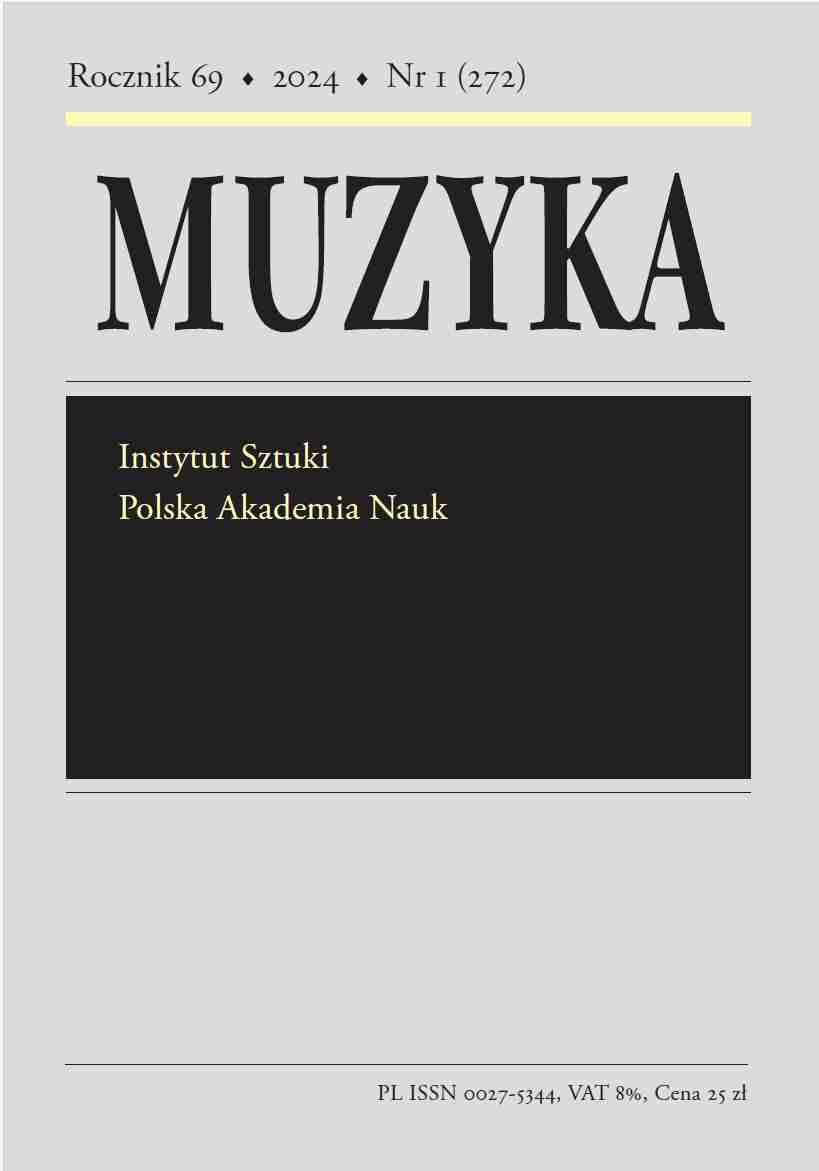‘Koperczaki’ and ‘Dmuchawce’. The Discovery of Witold Lutosławski’s Folk Compositions
Abstract
For more than half a century, researchers have been unaware of the existence of Witold Lutosławski’s two compositions, which have been discovered recently – both scores and recordings – in two archives: Paul Sacher Foundation and Polish Radio Archives. Both compositions have been classified as belonging to the applied music part of Lutosławski’s legacy. Koperczaki is one of the radio broadcasts written in collaboration with theatre director Jan Koecher, probably in 1949. The authors gave the work a structure of a vocal-instrumental suite, using texts of folk songs (or their paraphrases) from various regions of Poland. the music material consists of 13 folk tunes, mostly direct quotations, which were given simple accompaniment of an instrumental ensemble. In it, we find frequent consonances of fifths, compliance with the major-minor tonality framework, including conventional contrasts between the modes in free passages, simple rhythms and schematic structures of phrases and sentences. The radio broadcast was consonant with the then-propagated aesthetics of Socialist realism, which helped it become one of the most frequently aired works of applied music to which Lutosławski contributed.
Another recently discovered work is titled Dmuchawce and was composed in 1954 at the request of the „Skolimów” Song and Dance ensemble. This composition, lasting only five minutes and composed for vocal voices and a symphonic orchestra, is not entirely original. In writing it, the composer drew upon two dances (kaziorajka and maryszunka) from a cycle titled Ten Polish Dances for a chamber orchestra from 1953, which he provided with an introduction and a conclusion. The performance means offered by the orchestra gave Lutosławski an opportunity to explore fully the potential of folk themes by lending them a richness of colour, especially in the scope offered by orchestral colouring. More significance is attached here to articulation, and dissonances so characteristic of Lutosławski’s autonomous works are also present. Both compositions are a historically significant testimony to a development in music that would have never emerged had it not been for the establishment of Socialist realism as the dominant aesthetic doctrine in Poland.
Supporting Agencies
Statistics
Abstract views: 221PDF downloads: 129
License
Copyright (c) 2024 Wioleta Muras

This work is licensed under a Creative Commons Attribution 4.0 International License.
The author grants the publisher a royalty-free nonexclusive licence (CC BY 4.0) to use the article in Muzyka, retains full copyright, and agrees to identify the work as first having been published in "Muzyka" should it be published or used again (download licence agreement). By submitting an article the author agrees to make it available under CC BY 4.0 license.
Articles from 2018/1 to 2022/3 were published under a Creative Commons license CC BY-NC-ND 4.0. During this period the authors granted the publisher a royalty-free nonexclusive license (CC BY-ND 4.0) to use their article in "Muzyka", retained full copyright, and agreed to identify the work as first having been published in our journal should it be published or used again.
Most read articles by the same author(s)
- Wioleta Muras, Aleksander Zarzycki’s Piano Concertos: New Findings in the Light of Existing Sources , Muzyka: Vol. 67 No. 4 (2022)
- Wioleta Muras, Two Visions of Music. The Scores by Zbigniew Turski and Stefan Kisielewski for Two Productions of Juliusz Słowacki’s ‘Kordian’ in 1956 , Muzyka: Vol. 67 No. 2 (2022)
- Wioleta Muras, Artur Malawski’s Music for the 1957 Kraków Production of Stanisław Wyspiański’s 'Wyzwolenie' (Liberation) in the Context of the Political Thaw , Muzyka: Vol. 65 No. 3 (2020)
- Wioleta Muras, The Warsaw Music Society’s First Year of Activity. New Findings , Muzyka: Vol. 69 No. 3 (2024)
- Wioleta Muras, Witold Lutosławski’s Artistic Collaboration with the Polish Theatre in Warsaw (1948–1958) , Muzyka: Vol. 61 No. 1 (2016)
- Wioleta Muras, On the Trail of an Auditory Imagination. Witold Lutosławski’s Music in Radio Plays Produced by Polish Radio , Muzyka: Vol. 61 No. 2 (2016)










